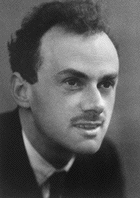Paul Dirac (1902-1984)
| ScienceWeek |
|---|
| TOC | A Single Cell Living 250 Million Years? | Cryptochromes | Sleep and the Brain | Neural Stem Cells and the Origin of Gliomas | Ice-Sheet and Sea-Level Changes | Paul Dirac (1902-1984) |
Mục lục
HISTORY OF PHYSICS: ON PAUL DIRAC (1902-1984)
The following points are made by Graham Farmelo (Nature 2005 437:323):
1) Of the few authentic visionaries modern science has known, Paul Dirac was the most inscrutable. He was a man of legendary quietness and privacy. His peers were bemused by his strikingly unusual way of looking at the world, while also amazed by the fecundity of his methods. Beginning in 1925, Dirac spent eight years developing quantum mechanics in a series of elegant papers that repeatedly took theoretical physicists by surprise. What, they wondered, lay behind Dirac's unique methods?
2) But colleagues seeking clues about the provenance of Dirac's ideas found none in his papers. He began each one with a deceptively straightforward, equationless introduction, before steam hammering his way through the mathematics, giving no quarter either to the faint hearted or to pedants. Few of his papers contained a diagram and none offered any solace to readers trying to visualize what was represented by the blizzard of abstractions. Dirac would respond to requests to express his quantum reasoning in words or pictures by impassively shaking his head. So it is hardly surprising that Dirac's peers perceived him to be, above all, a brilliant algebraist -- extremely adept at manipulating abstract symbols, but uninterested in visualization.
3) Yet Dirac insisted that he was not primarily an algebraic theoretician. This insistence first emerged almost 40 years after his first quantum papers were published, during an interview with the historian of science Thomas Kuhn (1922-1996) in the spring of 1963. Dirac declared to Kuhn that his approach was fundamentally geometrical and that he was "just no good" at doing "masses of algebraic calculations without picturing what the equation means". Robert Oppenheimer (1904-1967), Dirac's close friend and admirer, was incredulous when he heard this. Oppenheimer had hardly ever seen Dirac draw a diagram but had always been awed by his algebraic skill. No, Oppenheimer assured Kuhn, Dirac was "principally algebraic". Indeed, Oppenheimer went further and commented that Dirac's approach to physics was intuitive, like the mumbling savant Niels Bohr (1885-1962), although the two had completely different ways of communicating. "Bohr regarded mathematics as Dirac regards words, namely as a way to make himself intelligible to other people, which he hardly needs," Oppenheimer said.
4) In a scientific memoir nine years later, Dirac divided mathematicians cleanly into algebraists and geometers (the field of analysis apparently did not count). He had observed that mathematicians with a European training tended to be interested in geometry, following the school of the ancient Greeks, whereas those from an Asian background preferred algebra, which was originally discovered by the Arabs. Dirac remarked that his own preference was "strongly on the side of geometry, and has always remained so". Dirac often said that when he was developing quantum mechanics he used his favorite branch of mathematics --projective geometry -- which concerns the relationships between points and straight lines. But why then did he not mention geometry in his early papers? He expunged his geometrical thinking from his early work, he often said in the 1970s, because it was especially expensive in those days for journals to print diagrams and because he thought most physicists were unfamiliar with projective geometry. Only later, when John von Neumann (1903-1957)invented "state vectors" did the geometric content of quantum mechanics become plain.[1,2]
References (abridged)[sửa]
- Galison, P. The Suppressed Drawing: Paul Dirac's Hidden Geometry 145-166 (Univ. California Press, 2000).
- Darrigol, O. in From c-numbers to q-numbers Ch. 6 (Univ. California Press, 1992).
Xem thêm[sửa]
Copyright[sửa]
Graham Farmelo and Nature http://www.nature.com/nature


